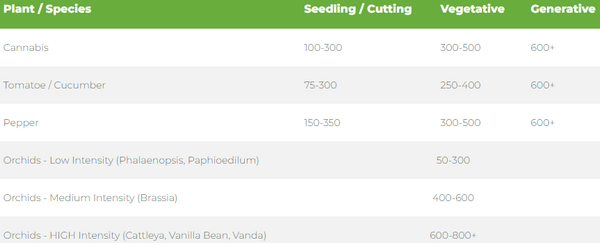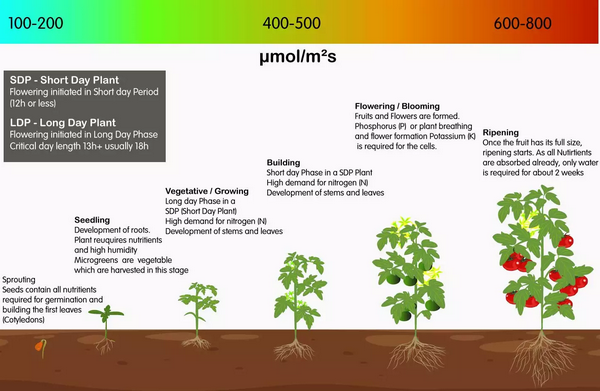Based on the plant's natural habitat, all plants and crops require a different light intensity in each growing phase for optimal plant development. Therefore, the required light intensity is different from crop to crop. Next to that, every crop is in need of a different illumination length.
The HortiOne team elaborates on the most suitable light intensity for particular plants, and the most suitable illumination length they need, depending on their 'flowering period'. Many flowering plants (angiosperms) use a photoreceptor protein, such as phytochrome or cryptochrome, to sense seasonal changes in night length.
The phytochrome conversion (Pfr to Pr) allows the plant to sense when it is night or day. The biologically-inactive form of phytochrome (Pr) is converted to the biologically-active form Pfr my the illumination with red light (mainly 660nm). Far-red (630nm) light and darkness convert the molecule back to the inactive form. 
Flowering timespan
Taking 'long day plants e.g., these are plants that flower when the days are longer. They require more than the critical duration of light to flower (usually 14-18 hours). They are also called ‘short night plants’. Such as spinach, radish, hibiscus, wheat and lettuce.
There are also some 'short-day plants, such as soybean, tobacco, chrysanthemum, cannabis Sativa L. etc. They need less than the critical duration of light (about 8-12 hours) and a continuous dark period (about 14-16 hours) to flower. A continuous dark period is very critical for SDP plants. They are also called ‘long night plants’.
Whereas, 'neutral day plants', such as tomatoes, pea plants, rose, cannabis ruderalis etc., do not have critical daylength. Therefore, they are ‘neutral’ to the length of day or night. The terms automatic and automatic-flowering plants have established.
Light intensity
Therefore, the current daylength (length of illumination) controls, depending on the plant’s type: (SDP, LDP, NDP) which growing-phase is currently initiated. As a simplified version usually people differentiate between the following phases for a short-day plant: germination (sprouting)/cuttings, vegetative (growing), generative (flowering/blooming), and harvest (finished).

The HortiOne team notes: "As the sunlight is a perfect full-spectrum light, light intensities using artificial lighting are depending on the spectrum. The possible light intensities are usually lower."

Plant growing phases
Light or CO2 limited?
Besides water and light, plants require a variety of so-called macro (N, P, K) and micronutrients. During photosynthesis uses light energy to convert water, carbon dioxide (CO2), and minerals into oxygen and energy-rich organic compounds. Depending on the light intensity each part like macronutrients (N, P, K) and micronutrients can lead to limitations in growth and development. While most substances can be applied quite easily, carbon dioxide has a special role.
The natural level ranges from 400 to 450 parts per million (ppm) of the earth’s atmosphere. Low light intensities can limit plant growth, at a certain point CO2 becomes the most limiting factor and supplemental CO2 can be required to achieve further increase. The point where it requires is depending on the plant species and genotype as well as the required amount of artificial CO2 is depending on numerous factors.
Daily Light Integral (DLI)
DLI stands for the delivered amount of light in a 24 hour period. It is possible to increase the amount of light (DLI) by increasing the illumination period. It is important to stay in the required photoperiod (long/short day period).
Therefore, when choosing crop lighting, always double-check how long it takes for your crop to flower in order to choose the right light intensity, and see whether you're not limited on either light or CO2 because this will affect crops tremendously.

For more information:
HortiOne
www.hortione.com
